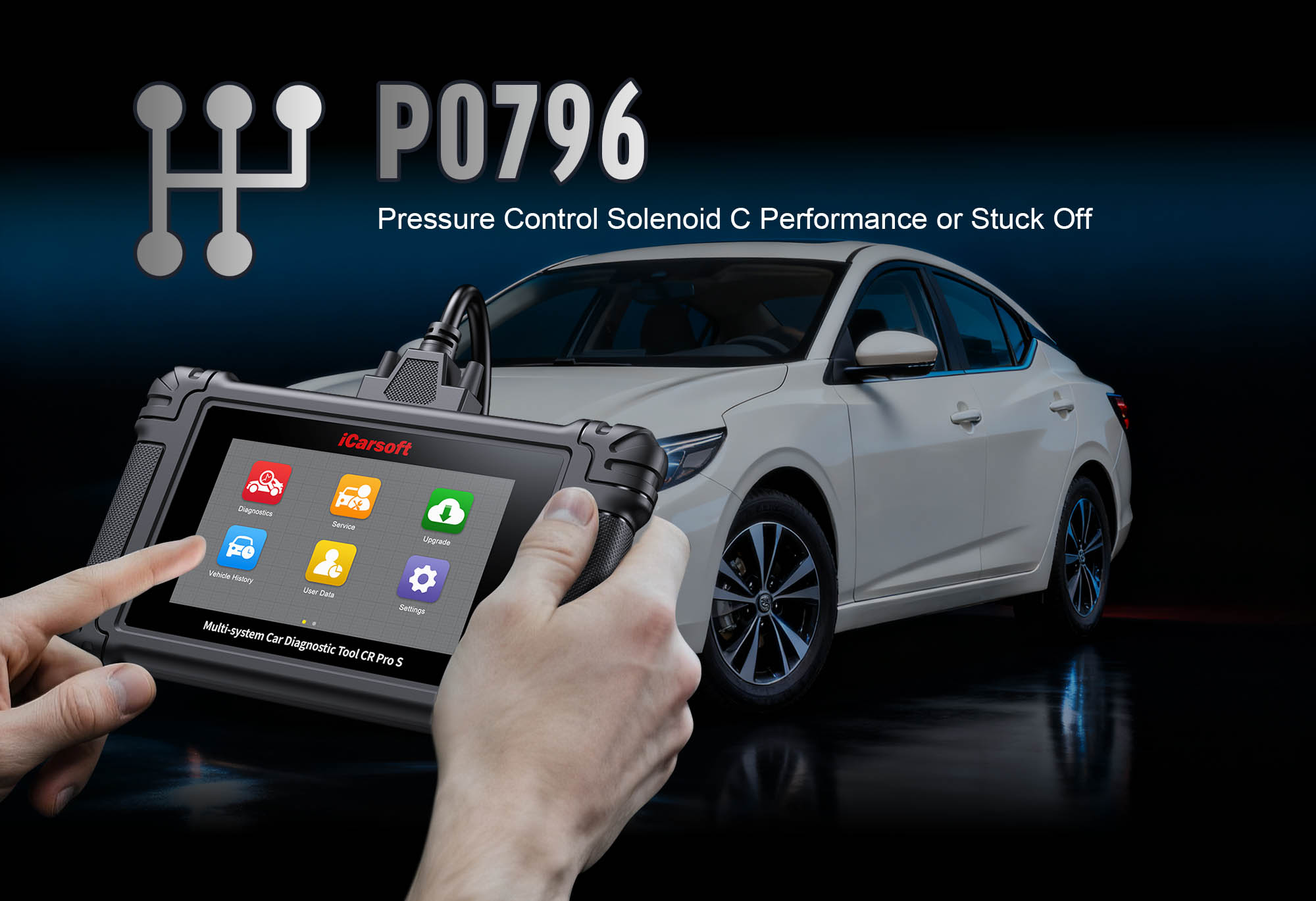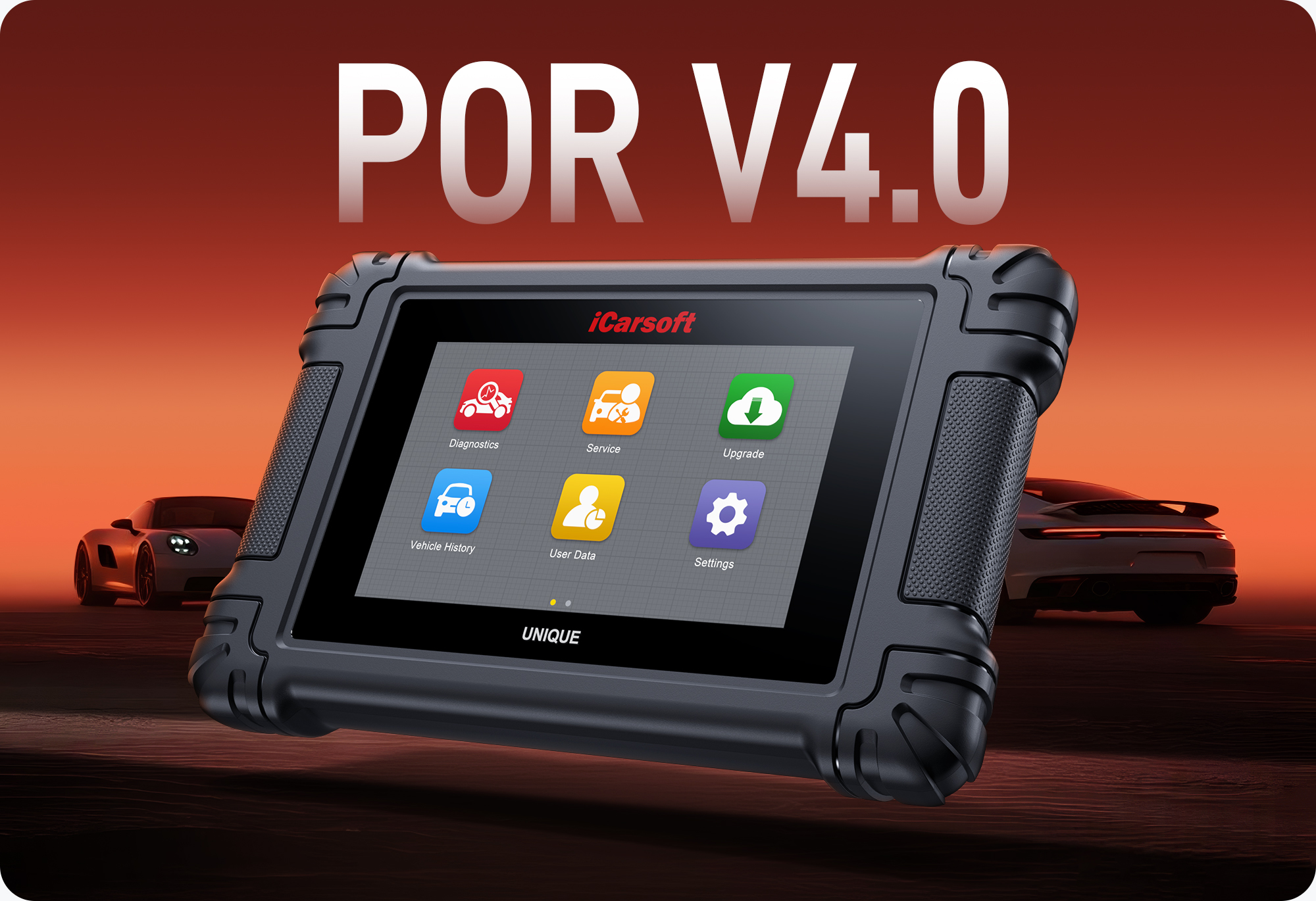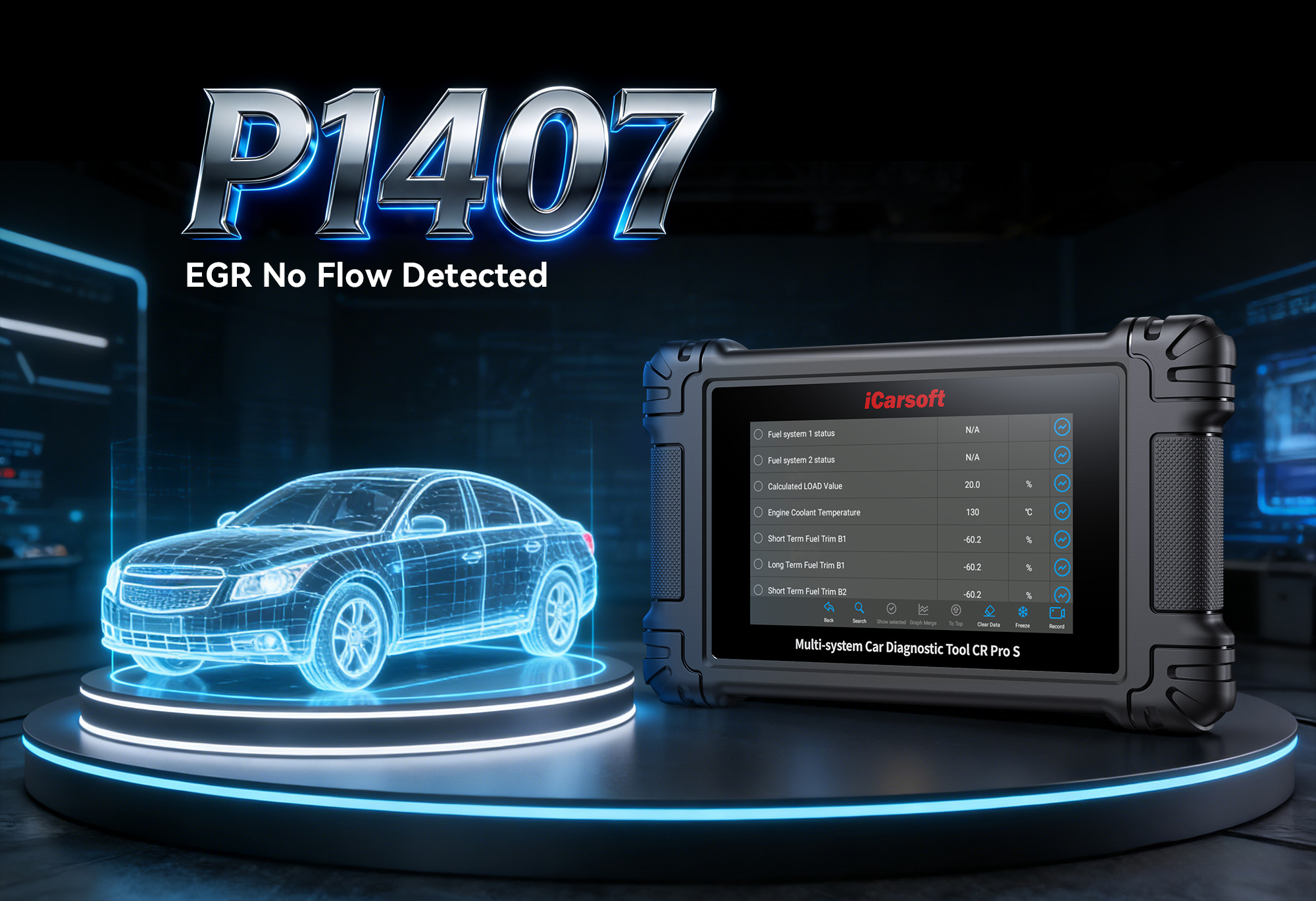P0796 Code: Diagnose & Clear Pressure Control Solenoid C Performance/Stuck Off with iCarsoft CR Pro S
If your check engine light illuminates and you experience erratic mid-range shifting, transmission hesitation during acceleration, or a "jolt" when changing gears (e.g., 3rd to 4th), a diagnostic scan will likely return P0796. This OBD-II code stands for "Pressure Control Solenoid C Performance/Stuck Off," signaling a malfunction in the solenoid responsible for regulating hydraulic pressure for specific transmission gear changes—critical for smooth, efficient power delivery.
Modern automatic transmissions rely on a set of pressure control solenoids (labeled A, B, C, etc., based on transmission design) to manage fluid pressure in the valve body. Solenoid C typically controls pressure for higher-range gear shifts (e.g., 3rd→4th or 4th→5th) or torque converter clutch adjustments in complex transmissions (like 6-speed, 8-speed, or CVT systems). When it malfunctions—either by failing to activate (stuck off) or delivering inconsistent pressure—the Transmission Control Module (TCM) can’t fine-tune pressure for these shifts. This leads to harsh gear changes, increased clutch/brake band wear, and potential transmission overheating if left unaddressed.
Basic scanners may only flag "solenoid C fault" but can’t test solenoid functionality or isolate pressure-related issues. The iCarsoft CR Pro S, with its bi-directional solenoid control, live hydraulic pressure monitoring, and global transmission coverage, solves this. Let’s walk through how to diagnose and resolve P0796 with precision.
Understanding P0796: Causes & Key Symptoms
A faulty Pressure Control Solenoid C disrupts hydraulic pressure for critical gear shifts, with symptoms that worsen during high-speed or mid-range driving—these clues help distinguish electrical vs. mechanical issues.
Key Symptoms of P0796
-
Harsh Mid-Range Shifts: The transmission "slams" into higher gears (e.g., 3rd to 4th) instead of shifting smoothly—caused by unregulated pressure spikes.
-
Transmission Hesitation: A 1–2 second delay when accelerating to higher speeds (e.g., merging onto the highway) as the TCM struggles to engage gears.
-
Slipping in High Gears: The engine revs higher than normal at 50+ mph (e.g., 3,000 RPM at 60 mph) but vehicle speed doesn’t increase proportionally—pressure is too low to hold gears.
-
Reduced Fuel Efficiency: Inefficient shifts and slipping force the engine to work harder, lowering MPG by 5–12%.
-
Transmission Warning Light: Many vehicles (e.g., GM, Ford, Toyota) trigger a dedicated "Transmission" light alongside the check engine light.
-
Limp Mode Activation: To prevent damage, the TCM may lock the transmission in 2nd or 3rd gear, limiting speed to 35–45 mph.
Common Causes of P0796
|
Cause
|
Description
|
|
Faulty Pressure Control Solenoid C
|
Internal electrical burnout (open circuit) or mechanical sticking (debris buildup) prevents the solenoid from opening/closing.
|
|
Low/Degraded Transmission Fluid
|
Insufficient fluid pressure (low levels) or clogged passages (old, dark fluid) starve Solenoid C of hydraulic power.
|
|
Clogged Valve Body
|
Debris (metal shavings from worn clutches, sludge from old fluid) blocks the valve supplying pressure to Solenoid C.
|
|
Wiring/Connector Issues
|
Corroded terminals, frayed wires, or loose plugs disrupt power/signals between the TCM and Solenoid C.
|
|
TCM Malfunction
|
Outdated firmware or internal faults cause the TCM to send incorrect voltage to Solenoid C (common in 2017+ vehicles).
|
|
Failed Pressure Sensor
|
A faulty sensor sends inaccurate data to the TCM, triggering false P0796 by misjudging solenoid performance.
|
Why iCarsoft CR Pro S Excels at Diagnosing P0796
The CR Pro S outperforms basic tools with features tailored to complex transmission diagnostics—critical for isolating the root cause of P0796:
Bi-Directional Solenoid Control
Manually activates Solenoid C to test opening/closing and pressure regulation—eliminates guesswork about functionality.
Live Hydraulic Pressure Monitoring
Tracks real-time pressure for supported transmissions (e.g., GM 6L80, ZF 8HP) to confirm solenoid performance.
Global Transmission Coverage
Works with 500+ models (Mercedes-Benz, BMW, Toyota) and transmission types—critical for Solenoid C’s varying roles.
3D Component Mapping
Displays high-res diagrams of Solenoid C, valve body paths, and wiring—avoids misdisassembly and speeds diagnosis.
Lifetime Free TCM Updates
Wi-Fi updates fix P0796 false triggers from outdated TCM software (common in modern 8-speed transmissions).
Fluid & Voltage Health Checks
Guides fluid level/quality inspection and battery voltage tests (low voltage disrupts solenoid operation).
Step-by-Step: Diagnose P0796 with iCarsoft CR Pro S
-
Check Transmission Fluid First (Critical!)
1. Park on level ground, start the engine, and let it reach operating temperature (5–10 minutes).
2. Locate the transmission dipstick (use CR Pro S’s Component Location tool) or fill port (sealed transmissions).
3. Fluid Level: For dipstick models, ensure fluid is between "MIN" and "MAX." For sealed units, use Transmission Fluid Temperature (TFT) Readout (175–200°F) then check via fill port.
4. Fluid Quality: Healthy fluid = bright red, odorless. Dark brown/black + burnt smell = degraded (needs replacement + filter service).
-
Connect the CR Pro S & Confirm the Code
1. Plug the CR Pro S into the OBD-II port (use OBDI adaptors for older models: Mercedes 38Pin, BMW 20Pin).
2. Select your vehicle via Auto VIN Identify (instant specs) or manual entry.
3. Navigate to Transmission > Fault Codes > Read Codes to confirm P0796. Tap Code Details for vehicle-specific tips (e.g., "Chevrolet Silverado: Check Solenoid C on Valve Body").
-
Locate Pressure Control Solenoid C & Key Components
1. Go to Component Location > Transmission > Solenoids > Pressure Control Solenoid C.
2. Use the diagram to identify key parts:
- Pressure Control Solenoid C: On transmission valve body (inside pan or side of case) with 2–3 pin connector.
- Valve Body: Distributes fluid to solenoids—clogs here affect Solenoid C’s pressure.
- Wiring Harness: Path to TCM (check for damage near exhaust/drive shafts).
- Pressure Sensor: (If equipped) Sends pressure data to the TCM.
-
Analyze Live Transmission Data
1. Start the engine, shift to Drive, and accelerate to 60 mph (trigger high-range shifts).
2. Navigate to Transmission > Live Data > Solenoids & Pressure and monitor:
- Solenoid C Voltage: Fluctuates with high-range shifts (0.5–12V). P0796 = constant 0V (stuck off) or erratic spikes.
- Hydraulic Pressure (supported models): Rises/falls smoothly (e.g., 50–70 psi for 3rd→4th). Flatline = solenoid stuck off; spiking = clogged valve.
- Input/Output Speed Mismatch: 2,500 RPM input → 2,400 RPM output (4th gear) = healthy; >10% slip = pressure failure.
- TCM Command vs. Actual State: TCM "commands on" but sensor shows "off" = solenoid/circuit fault.
-
Test Solenoid C with Bi-Directional Control
1. Manual Solenoid Activation: - Idle engine (parking brake on). Go to Special Functions > Transmission > Actuation Tests > Pressure Control Solenoid C.
- Adjust voltage 0.5V–12V:
- Response Check: Listen for "click" (open/close) and feel case vibrations (pressure changes). No response = faulty solenoid.
- Pressure Readout: Pressure should vary with voltage. No change = stuck off or clogged valve.
2. Solenoid Resistance Test: - Turn off engine, disconnect solenoid connector. Use CR Pro S’s Multimeter Function: Normal = 10–30 ohms. Infinite = open circuit; <5 ohms = short.
-
Inspect Wiring, Connectors, & Valve Body
1. Wiring/Circuit Check: - Use Circuit Continuity Test between Solenoid C’s signal pin and TCM (normal = <5 ohms). High resistance = frayed wire; 0 ohms = short.
2. Connector Cleaning: - Clean corroded terminals with electrical contact cleaner (water intrusion causes signal loss).
3. Valve Body Inspection: - If fluid is dirty, remove transmission pan (use Torque Guide for bolts). Clean debris from Solenoid C’s inlet with transmission-specific cleaner.
-
Rule Out TCM or Pressure Sensor Issues
1. TCM Firmware Update: - Go to System > Update Manager to install free updates (fixes miscalculated solenoid commands).
2. Pressure Sensor Calibration: - Use Sensor Calibration Test to verify sensor accuracy. Compare to mechanical gauge (if available). Faulty sensor = replace to resolve false P0796.
-
Repair & Clear P0796
1. Fix the root cause:
- Fluid Issues: Drain/replace fluid + filter (use Service Guide for type/capacity).
- Faulty Solenoid C: Replace with OEM part (use Part Lookup).
- Wiring/Circuit: Splice wires, repair shorts, or replace connectors.
- Clogged Valve Body: Clean or replace (consult pro for complex transmissions like ZF 8HP).
- TCM/Sensor: Update firmware or replace pressure sensor.
2. Clear the code: Navigate to Transmission > Fault Codes > Clear Codes to delete P0796.
-
Validate the Repair
1. Recheck live data: Solenoid C voltage fluctuates with shifts; pressure (supported models) is consistent.
2. Test drive 30–40 minutes: Accelerate through all gears—no harsh shifts, slipping, or warning lights.
3. Post-drive scan: Use Transmission System Scan after 50 miles to confirm P0796 doesn’t return.
Preventing P0796 Recurrence
Use the iCarsoft CR Pro S to maintain transmission health and avoid future Solenoid C issues:
-
Fluid Maintenance: Set Service Reminder to replace transmission fluid every 60,000 miles (40,000 miles for towing/stop-and-go driving).
-
Solenoid Health Checks: Include Pressure Control Solenoid C in annual electrical scans—test resistance and activation to catch early faults.
-
TCM Updates: Enable Update Alerts to install firmware fixes for advanced transmission solenoid control.
-
Gentle Driving Habits: Avoid aggressive acceleration (reduces pressure spikes) and don’t shift between Drive/Reverse while moving.
Conclusion
P0796’s Pressure Control Solenoid C issue disrupts high-range shifts and threatens transmission longevity—but the iCarsoft CR Pro S turns complex diagnostics into a manageable process. With bi-directional control, live pressure monitoring, and global coverage, it ensures you fix the root cause (not just replace parts blindly).
By using the CR Pro S to resolve P0796, you’ll restore smooth high-speed shifts, boost fuel efficiency, and protect your transmission from costly wear—keeping your vehicle reliable for miles to come.
FAQs About P0796 Code
Q: Can I drive with P0796?
A: Short trips at low speeds are possible, but prolonged driving causes clutch/bearing wear and overheating. If limp mode activates or shifts are harsh, limit driving and address P0796 within 1 week.
Q: How much does it cost to fix P0796?
A: $100–$250 for an OEM Pressure Control Solenoid C; $100–$300 for fluid/filter service; $500–$1,200 for valve body repair/replacement (plus labor). TCM updates are free via the CR Pro S, saving on dealer fees.
Q: Is P0796 related to P0776?
A: Both relate to pressure control solenoids but target different solenoids (C vs. B). P0796 affects high-range shifts, while P0776 impacts mid-range shifts. The CR Pro S differentiates via transmission mapping and live data.
Q: Can a dirty transmission pan cause P0796?
A: Indirectly—a dirty pan leads to debris in the valve body, clogging Solenoid C’s inlet. Regular fluid changes prevent this, but if P0796 is triggered, clean the valve body and replace fluid/filter.





